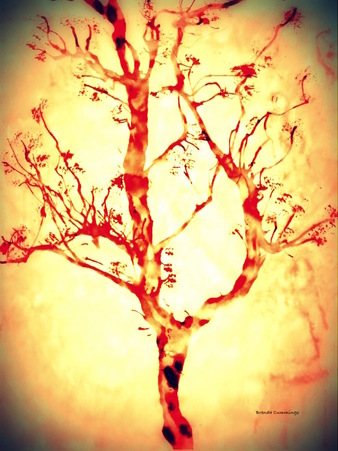
We all know about California’s drought and the impact it’s having on agriculture. We’ve all heard about the changes in behavior so many Californians have had to make to reduce their water usage. We’ve all heard the awful news about California’s seemingly endless wildfires. The extent to which trees are being affected in California is an environmental problem that may be insurmountable. An estimated 30 million California trees perished last year alone, and this is happening at a time when California (and the planet) needs forests desperately. This is the fifth year of California’s drought.
If the fires aren’t devastating enough, other crushing problems occur when trees don’t get enough water. They become so debilitated that they develop extreme susceptibility to parasites. The resin that flows through the cells in the inner bark of trees works very much like the blood that flows through our veins. Trees need water to produce resin. If they can’t make resin, not only do they starve, the resin can no longer do its job as a natural pesticide.
The worst of California’s tree pests is the bark beetle, a tiny insect, no bigger than a grain of rice, which can be more devastating than fires. Bark beetles bore holes into trees, crawl in, and reproduce. They also bring fungi into the trees, causing them to rot from the inside out. The Stanislaus, Sierra and Sequoia National Forests in the Sierra Nevadas have been hit the hardest by the bark beetle, and it is estimated that bark beetles have killed over 29 million trees. They attack coniferous and hardwood trees, including Ponderosa pine, Jeffrey pine and pinyon trees.
It gets worse. Sudden oak death (SOD) is a plant disease (Phytophthora ramorum) that attacks California trees in epidemic proportions. SOD has primarily affected oaks and tanoaks. It started on the central and northern coast of California and has spread as far north as Curry County, Oregon. The pathogen can also infect rhododendrons, camellias, redwoods, huckleberry, as well as other plants and ferns but it doesn’t seem to kill them. Ironically, SOD has a much lower mortality rate in the drier areas because rain allows the disease to spread even faster - but as oaks and tanoaks die from SOD, they become fodder for more fires. It’s estimated that around 90 million trees have died from SOD since 2000.
It is beginning to look like California trees can’t catch a break. When trees are affected, everything is affected, including the rest of the country and ultimately, the entire planet.
If the fires aren’t devastating enough, other crushing problems occur when trees don’t get enough water. They become so debilitated that they develop extreme susceptibility to parasites. The resin that flows through the cells in the inner bark of trees works very much like the blood that flows through our veins. Trees need water to produce resin. If they can’t make resin, not only do they starve, the resin can no longer do its job as a natural pesticide.
The worst of California’s tree pests is the bark beetle, a tiny insect, no bigger than a grain of rice, which can be more devastating than fires. Bark beetles bore holes into trees, crawl in, and reproduce. They also bring fungi into the trees, causing them to rot from the inside out. The Stanislaus, Sierra and Sequoia National Forests in the Sierra Nevadas have been hit the hardest by the bark beetle, and it is estimated that bark beetles have killed over 29 million trees. They attack coniferous and hardwood trees, including Ponderosa pine, Jeffrey pine and pinyon trees.
It gets worse. Sudden oak death (SOD) is a plant disease (Phytophthora ramorum) that attacks California trees in epidemic proportions. SOD has primarily affected oaks and tanoaks. It started on the central and northern coast of California and has spread as far north as Curry County, Oregon. The pathogen can also infect rhododendrons, camellias, redwoods, huckleberry, as well as other plants and ferns but it doesn’t seem to kill them. Ironically, SOD has a much lower mortality rate in the drier areas because rain allows the disease to spread even faster - but as oaks and tanoaks die from SOD, they become fodder for more fires. It’s estimated that around 90 million trees have died from SOD since 2000.
It is beginning to look like California trees can’t catch a break. When trees are affected, everything is affected, including the rest of the country and ultimately, the entire planet.

 RSS Feed
RSS Feed
